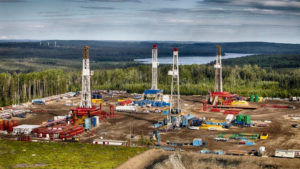But advocate wonders if government is using natural gas as just a pitch to get more infrastructure

Drill, baby, drill.
The Northwest Territories’ “vision” for energy and climate change includes encouraging companies to invest in the territory’s natural gas.
It seems counterintuitive, as natural gas has been criticized for being a greenhouse gas emitter that could delay implementing more renewable energy.
But in the territory, 23 out of 33 communities rely on diesel fuel — which emits about 25 per cent more carbon and other pollutants into the atmosphere, according to numbers from one of three new territorial government reports that focus on climate change and the energy industry.
Diesel fuel must be brought up from the south, adding further emissions, said Mackenzie McEachern, director of mineral and petroleum resources with the territorial government.
“Displacing diesel — which has to be transported from southern Canada — you also reduce emissions from the transportation of that fuel.”
McEachern points to China, where natural gas plants are being built as coal power plants are decommissioned.
He is also interested in seeing the territory’s natural gas sold internationally.
“If we have excess local production in addition to supplying our own needs we might supply it to export markets around the world as well,” he said.
According to the government’s new Petroleum Resources Strategy, the Northwest Territories has a potential of 1.2 billion barrels of conventional oil and 16.4 trillion cubic feet of “discovered and recoverable” conventional natural gas.
“Certainly, if we have this resource we might as well use it,” McEachern said.
Just a ‘pitch’ for industry?
That gives Dale Marshall, national program manager with the advocacy group Environmental Defence, pause.
“I’m just wondering if access to natural gas is being used as a pitch for developing further infrastructure in oil and gas development,” Marshall said.
“I think there’s merit in local communities getting access to energy and becoming self sufficient … but it’s not clear to me whether that will be used as a rationale for greater investment in fossil fuel infrastructure that will increase carbon emissions.”
The petroleum strategy notes its aim is to restore the confidence and investment in the territory’s petroleum resources industry. It also says that it will promote smaller-scale natural gas projects that meet the needs of the communities and businesses.
Marshall said that getting communities off diesel fuel is a good goal.
“Diesel is a really dirty energy source so it’s bad for health in local communities and it’s bad for greenhouse gases; switching to natural gas probably makes sense for both those considerations,” he said.
“The question is whether there might be even better alternatives.”
Marshall pointed out wind and solar as examples.
Climate vision includes lower emissions
The petroleum strategy also notes that there may be “unconventional” shale gas available in places like the Devonian Canol Formation and Cretaceous Slater River Formation.
Shale gas is exported through a process called hydraulic fracturing, or fracking, which has been controversial for its potential to cause seismic tremors and pollution of groundwater.
But along with the petroleum strategy, the territorial government also announced two others: the Climate Change Strategic Framework and the 2030 Energy Strategy.
The three documents are expected to form the basis of how they will deal with climate change, cost of living and energy security in the territory. Plans for wind, solar, and hydroelectric power are included in the documents.
In a press release, the territory announced that they planned to reduce greenhouse gas emissions by 30 per cent below 2005 levels by 2030.
They also plan to reduce energy used for heating and greenhouse gas emissions used by road vehicles, according to the release.
An October 2017 report from Canada’s Auditor General found that the territorial government had failed to systemically respond to the problem of climate change, instead relying on a “piecemeal” approach.


